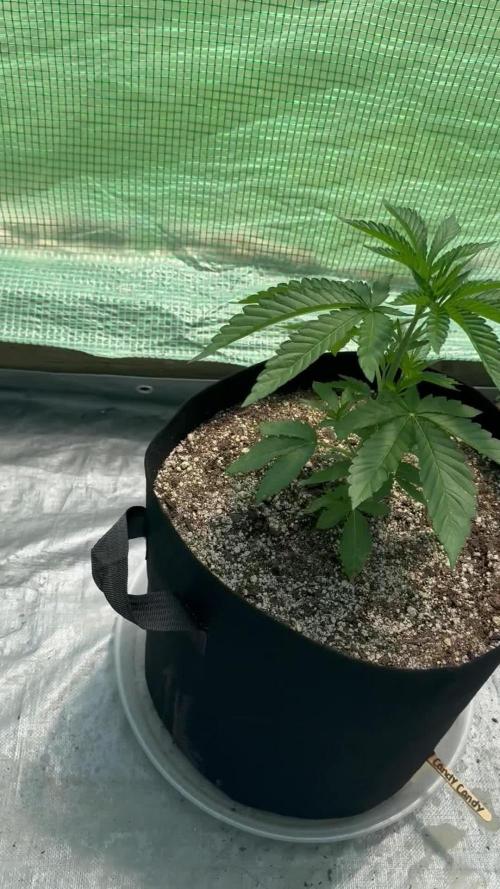The Grow Awards 2026 🏆 



































Likes
Comments
Share


@AlpenZilla
Follow
We are at the beginning of the 9th week of flowering. The trichomes are slowly beginning to change color.
I'm now going on vacation for 9 days, I couldn't have planned it any shittier. But anyway, I've decided to keep them growing and then probably harvest them straight after my vacation.
Likes
8
Share


@Hempface86
Follow
Ladies and gentlemen, today's day 27 of veg and as you can tell, I mainlined her
. In the video I explain how I plan on mainlining, both tops after the fifth node.. But what I failed to mention was that I will also be topping again as well at that point.. So from there on it will be LST and try to get as good of a yield, as we can out of this girl.. Pineapple dream sounds like a good one.So the more of it I can get, the better right lol .. God bless everybody i hope everybody's doing well and so are their plants..happy growing ✌️
Likes
4
Share


@Barcelona_Farmers710
Follow
Explosión de resina!!! Una genética que no me deja de sorprender un olor brutal a cítricos y su olor a Haze un gustazo pra la vista y el paladar sin duda esperamos impacientemente el dia de degustar este manjar!! Espero que os guste Salut y força al canut Farmers!🍁
Likes
4
Share


@Canadian
Follow
Nothing to really say except that they are growing very well Thank you for reading I will continue to update have a happy grow
Likes
4
Share


@el_cultivito
Follow
Found some fungus growing on the top soil then also started seeing it on the bottoms of the fabric pots.
Definetely think its from over watering them last week.
Dealing with fungus gnats with some house plants in my living room so I sprinkled ceylon cinnamon on the top soil to act as an organic fungicide and attempt to prevent a fungus gnat infestation.
Will be letting the soil dry out a good amount before next watering.
Likes
1
Share


@Weedwithwes
Follow
Day 42 week 6
Feed a bonide mixture 2nd time in a week. Pest have gotten worse but trying to manage persistently.
Growth seems to be picking up.
Added a 2nd mars hydro Cree 128 as I got a new flower light.
Trying to get them used to the new lights and a better ppfd range as I was using the wrong measurements for the past year of growing around 75 umol range … surprising yeilds though with knock off lights in those conditions looking back on it.
Next grow will be smooth hopefully lol
Day 47
Top dressed
444 Gia green 2 tbps
Alfalfa meal 1 tbsp
Kelp meal 2 tbsp
Crab meal 2 tbsp
Asomite 1 tsp
Gradual humid acid 1 tsp
Glacier rock dust 1 tsp
1-1.5 tbsp of em bokashi bran
.5 mykos gruanual mycorrhizal fungi
Also sprinkled some langbeinite on I’m thinking there’s potassium deficiency in the soil mixture with this long veg and haven’t feed much potassium. Leafs showing some signs of it.
Added 1 inch mulch layer of rabbit compost/ wood chips and spread some clover seeds underneath.
Finally got my silica in the mail so soaked it all down with 3ml or 3 grams of 1 gallon of water split between each plant sprayed into soil evenly. They are already feed so this way just to get everything started under the new mulch layer.
Will spray bonide on plants to continue with any pest issues leftover.
Likes
14
Share


@HELLFIRE424
Follow
So far it looks like I have control of the nute burn looking at the fan leave not burning/changing anymore. Started finish but started at 5pm and my led goes off at 6pm. I kept flushing till 6:20om but stopped due to the fear of the ladies herming, revegging, or anything that would cause my ladies to start off week 7 on a slow/bad start. Defoiling a little but mostly real bad burned fan leave because I believe your ladies will continue to try and repair them which pulls energy from bud developement. Flushed on 6/1/22 and ended on 6/2/22 all 3 ladies ppm is under 200 so I can make sure they have enough to ripen and fatten up. On week 8, I will do a ice flush and then 2-3 days of darkness while they freeze. Checked trichomes on 6-5-22 and some show maybe 10-20% on some colas. Will harvest all 3 on 6-12-22 probably in the morning which I seen and heard it is better because at a certain time in the day marijuana plants let out moisture and you want to keep as much of that as possible.n
Likes
40
Share


@Mr_und_Ms_Lue_Roots
Follow
Gestern haben wir unser Pflanze entlaubt, damit sie Luft bekommt und weniger Ungeziefer mit ins Zelt bringt. Dann wurde sie gestretcht damit sie durch die Türen passt.
Im Zelt angekommen haben wir die Folie entfernt und haben die hohen Nebentriebe mit Strick unter Low-Stress Verfahren befestigt. Somit bekommen jetzt auch die unteren Triebe/ Blüten ausreichend und mehr Licht. Da sie jetzt sicherlich wieder ausreichend gestresst ist, sehen wir erstmal in den nächsten Tagen keine Entlaubung vor. Dies werden wir dann ca. Ende der Woche vornehmen. Bisher wenig Ungeziefer, zusätzlich haben wir 3 Gelbtafeln reingehangen. Die Lampe war gestern zur Eingewöhnung auf 400/600 Watt eingestellt, ab heute sind wir auf volle Leistung gegangen mit 720 Watt inkl. Deep Red Mode.
Wir freuen uns auf die folgende Woche und wünschen allen Growern eine schöne Restwoche und viel Erfolg beim Growen!
Likes
Comments
Share


@Chronickarl
Follow
The wedding cake in the top right of the pics is showing a slight sensitivity to the feed and has nutrient burn on some leaves, but the strawberry cough on the left hand side is being as good as ever not had any issues with it so far one of the easiest strains I've grown to date
Likes
Comments
Share


@Fuzzel
Follow
Good bud and visible trichome development.😍
Stretch seems to be slowing down by the end of this week.
Another round of MegaWorm and Guano powder spread on the soil this week.
Temperatures and and watering needs are increasing as the light is set to 100% this week. 160W of LED on about a third of a square meter should push these plants to some nice yields.🙌
Likes
44
Share


@PEAKYPLANTERS
Follow
Hi everyone, Weed brothers!
Welcome to the new Peaky experience that consists in growing in vegetation some photoperiod bean together with other autoflowering for a few weeks before isolating them in another tent under a 12-hour cycle.
BEST REGARDS
Likes
54
Share


@Mimi420
Follow
Hi growers!
My kushes are on FD 19.Not much streching thise time.Bubba Kush is al litle yelow,but showing nice grow.Started to add green sensation.
Stay green🌱
Likes
Comments
Share


@Cruzito
Follow
Almost killed one of the candy candy plants today by watering too fast ended up LST-ing all of the plants with the exception of the other candy candy which I am letting grow natural.
Likes
11
Share


@Paradox_1ste1
Follow
When i harvest it it looked very good in quality but it took some time to get dry so it maybe had a bad drying so thats why.
Likes
16
Share


@420DeepGrow
Follow
Gracias al equipo de Sweet Seeds, Marshydro, XpertNutrients y Trolmaster, sin ellos esto no sería posible.
💐🍁: Big Devil Fast Version:
Atendiendo a las peticiones de nuestros amigos y clientes, presentamos la versión feminizada y fotodependiente de nuestra apreciada variedad Big Devil Auto (SWS15).
Para el desarrollo de esta variedad utilizamos nuestras mejores cepas seleccionadas de Big Devil Auto. Hemos eliminado el carácter autofloreciente de la Big Devil Auto hibridando estas cepas seleccionadas con un clon élite de características muy semejantes a la Big Devil Auto original.
El resultado es una planta muy vigorosa, de gran porte y de muy alta producción, con cogollos muy densos y repletos de resina. Desarrolla un fuerte tallo principal y largas ramas laterales. Conserva el aroma y sabor de nuestra Big Devil Auto original, muy dulce e inciensado.
💡TS-3000 + TS-1000: se usaran dos de las lámparas de la serie TS de Marshydro, para cubrir todas las necesidades de las plantas durante el ciclo de cultivo, uso las dos lámparas en floracion para llegar a toda la carpa de 1.50 x 1.50 x 1.80.
https://marshydro.eu/products/mars-hydro-ts-3000-led-grow-light/
🏠 : Marshydro 1.50 x 1.50 x 1.80, carpa 100% estanca con ventanas laterales para llegar a todos los lugares durante el grow
https://marshydro.eu/products/diy-150x150x200cm-grow-tent-kit
🌬️💨 Marshydro 6inch + filtro carbon para evitar olores indeseables.
https://marshydro.eu/products/ifresh-smart-6inch-filter-kits/
💻 Trolmaster Tent-X TCS-1 como controlador de luz, optimiza tu cultivo con la última tecnología del mercado, desde donde puedes controlar todos los parametros.
https://www.trolmaster.com/Products/Details/TCS-1
📆 Semana 1:
Ha sido una buena semana, ella ha dado otro gran cambio en su lugar definitivo 😎. A uno de los ejemplares se le practicó la poda apical porque estaba destacando sobre el resto
La carpa está ocupada al 75% y comienza una floracion explosiva gracias a @Marshydro y @Xpertnutrients y @Trolmaster con esta gran genética 💪.
A partir de ahora se riega manualmente con las dosis recomendadas por el fabricante.
Processing
Likes
15
Share


@CannabisAprendiz
Follow
Hola , esta es la última semana de floración del seguimiento de las "WAKAS" , Se consiguió lograr un amarilleo más notorio en algunas plantas , estas estuvieron desde el 11 de noviembre solamente con agua , en total tuvieron 27 días sin fertilizantes que solamente se regó con agua.
se cortó este seguimiento el dia 8 de Diciembre guiándonos por la fase lunares con 70 dias de floracion y cerca de 102 días de vida total. Muy contento de poder haber cultivado esta genética que estoy con ansias de poder probar y testear.
dejamos igual un video con el espíritu navideño jajaj...
Hello, this is the last week of flowering of the follow-up of the "WAKAS", It was possible to achieve a more noticeable yellowing in some plants, the latter since November 11 only with water, in total they had 27 days without fertilizers that only watered with water
This follow-up was cut on December 8, guiding us through the lunar phase with 70 days of flowering and about 102 days of total life. Very happy to have cultivated this genetics that I am looking forward to being able to test and test.
we leave the same video with the Christmas spirit haha ..
Likes
100
Share


@AsNoriu
Follow
Day 23. Girls got pure water yesterday and all looking promising. One girl has tabaco mosaic or just intolerance to magnesium ;)))
Alaskan Diesel is my new love, amazing looking plants.
Some leave tucking and no other work done, just moving pots every day.
No plans, just pure jazz with them.
Got eviction notice, 21 of February is my last day, doubt I will make on time ;)))))
Happy Growing !!!
Processing
Likes
8
Share


@BigBaby420
Follow
Started with 2 Sour Chelumbians and 2 Lemon Haze Autos. Neither of the LH autos wanted to live so I started a bubba kush and a white widow to be in the same tent. They will be about a week apart in life





















